| 235
|
CHAPTER 37
Martín Builds a Jointed Gurney
to Keep His Hips from Stiffening
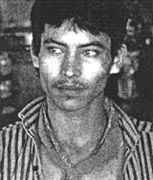
MARTÍN Pérez, since he was 10 years old, lived on
the streets in Culiacan, the capital city of the state of Sinaloa, Mexico.
He survived by stealing, doing odd jobs, and trafficking drugs. At age 15,
as a result of a gang dispute, he was shot through the spine and became
paraplegic (paralyzed from the middle of the back down). Upon his release
from the hospital, he was sent to PROJIMO.
On his arrival, Martín was near death from a urinary infection and
pressure sores that had developed in the hospital. He was angry and
depressed, but had the will and spirit of a survivor.
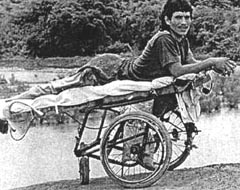
As is usual in PROJIMO, other spinal-cord injured persons took over
the management of Martín's urinary problem and pressure sores. In the
wheelchair shop, they built a wheeled cot, or gurney, so that he could be
active while lying on his stomach, and so his sores (on his backside)
would heal.
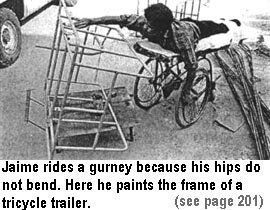
Frozen hips. Martín recovered his health, and his
sores healed in record time. But a new problem was developing. His hip
joints were beginning to ossify - in other words, the flesh
around the hip joints was beginning to turn into bone.
This problem, called myositis ossificans, occurs occasionally
in spinal-cord injured persons. It happened to Jaime, a worker in
PROJIMO's wheelchair shop. Because his hips are solidly fused into a
straight position, Jaime works while lying on a gurney (see photos on
pages 195, 200
and 247).
There is a debate among specialists as to what to do when myositis
ossificans starts to develop. Some recommend very limited motion of
the hips, in the belief that movement causes irritation and speeds the
deposit of bone. Others argue in favor of aggressive range-of-motion
exercises, to try to stop the joints from freezing up. Martín learned that
Jaime had not exercised during the time when his hips became ossified.
Therefore - at a stage when Martín's hips had almost no movement left - he
set about exercising to bring back flexibility. Every
morning his hips were so stiff he could barely move them. But he would
diligently exercise for an hour or more to recover lost range of motion.

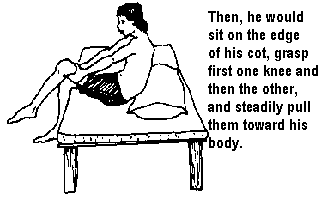
|
| 236
|
| With his persistent exercise
program, Martín managed, in time, to regain complete range of
motion of his hips. Nevertheless, every morning his hips would partially
"freeze up." For years, he had to keep up his morning exercise routine
to maintain flexibility. Martín's great strengths and
weaknesses. In PROJIMO, Martín's presence was a mixed blessing.
On the negative side, he had a violent temper which sometimes led to
acts of physical violence. He also used drugs (mainly marijuana) on the
PROJIMO grounds, even though drug use was prohibited by group decision.
He was also openly critical of weaknesses in the organization and its
leadership, which caused his own errors to be less tolerated.
(Eventually he was expelled.)
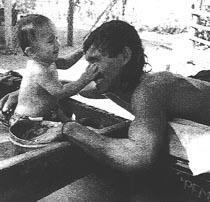
On the positive side, Martín developed into an extremely innovative
and creative wheelchair builder. He solved design problems in the
Whirlwind wheelchair that disability engineer Ralf Hotchkiss had
struggled with for years (such as a very simple mechanism to adjust the
angle of the footrests).
Ralf was so impressed with Martín's abilities that he invited him to
live in his home and to work in his shop for a number of months. Martín
even became a teaching assistant in Ralf's course in rehabilitation
design and engineering at San Francisco State University, in California.
Also on the positive side, Martín was very friendly and helpful to
some of the neediest disabled children at PROJIMO. Whenever they needed
help with their aids or equipment, they went to Martín, who would always
help them in a warm, personal, and effective way.
A Jointed Gurney for Post-Surgery Recovery
Martín was sometimes too active and hard working for his own good. He
had begun to use a wheelchair before the last pressure sore on his
backside had healed. As a result, the sore - although it had healed
except for a small opening on the surface - had formed a large and
stubborn cavity underneath. Periodically this cavity became infected.
Surgeons from Interplast (International Plastic Surgery) who
examined Martín decided he needed surgery to repair the deep sore. They
offered to do the operation free of charge, in Stanford, California.
Martín's biggest worry was the post-operative period. The surgeons
told him he would need to lie on a special "air bed" for 6 weeks, to
allow healing. But Martín - who knows his own body well - feared his
hips would freeze up forever if he lay flat for so long and could not do
his daily bending exercises. In order to maintain flexibility, he felt
that during the post-surgery period he needed to be positioned
at different and changing hip angles. He told the surgeons he
could make a jointed gurney with adjustable hip and knee angles to use
post-operatively. But the surgeons were skeptical.
|
| 237
|
| The surgeons doubted that Martín
could make a satisfactory gurney. And if he did, they doubted
that he would be able to lie on it face down all day long. But Martín
was persistent. The doctors decided to test him. They insisted that he
spend three days and nights continuously on the gurney, to prove that he
could do it without complications. Martín did this successfully, and the
doctors at last agreed to let him use the gurney following surgery,
instead of being on the special hospital bed.
Excellent results. To the doctors' amazement, on his
jointed gurney Martín's post-operative recovery went remarkably quickly
and well. They observed that Martín was very active on the gurney. They
agreed that such activity increased blood circulation, which probably
speeded surgical healing. (This finding is consistent with other
observations by the PROJIMO team on the healing of pressure sores, after
surgery and otherwise. See "Medical Treatment of Osvaldo's Pressure
Sores," page 252.)
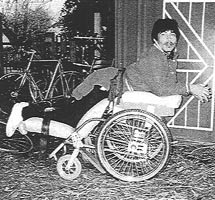 THE
GURNEY THE
GURNEY
The flexible gurney that Martín made for his post-surgical recovery
period was built on top of a standard donated wheelchair. The hip and
knee angles could be easily adjusted by hand. He upholstered each
section of the gurney with water-resistant vinyl (plastic cloth).

The above photos show Martín trying out his new gurney, and the
gurney alone in 3 of the many different positions to which it can be
adjusted. |
| 238
|
Different Kinds of Jointed Gurneys
Other jointed gurneys have been custom-built at PROJIMO and used by
persons with a variety of needs. Here is a gurney for a boy,
DANIEL, who is paraplegic due to tuberculosis of his spine.
When Daniel came to PROJIMO, his body, hips and knees were contracted in
a sitting position, and he had severe pressure sores. Therefore, the
team built for him an adjustable, jointed gurney that could gradually
straighten him out.
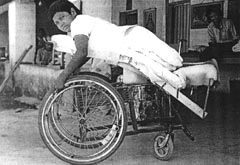
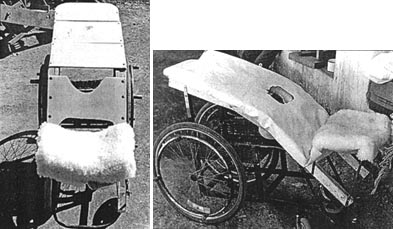
The gurney has a hole in it through which the boy can pass urine -
with or without a catheter - into a bag or bottle. (Spinal-cord injured
persons usually lack urine control. See page
147.)
In contrast, the next chapter describes a jointed gurney that was
built for a boy (Osvaldo) to gradually bend his hips and knees, which
had stiffened in an extended (straight) position.
Additional information on designs for wheeled cots or gurneys can be
found in the book, Disabled Village Children. Also see the next
chapter, pages 246-248.
|
|